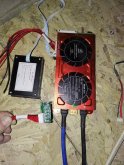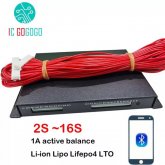So If you work with that and with a Victron BMV712 with low and high voltage cutoff, it also works likes a BMS right?
No, sadly it does
NOT!
I wish it did.
Lifepo4 (lithium general) doesn't self Balance like a 12v lead acid.
That have 6 cells, if there is voltage difference between them, it stabilise.
Lithium doesn't.
And it does get out of balance.
That's just how it works.
You can't stop this from happening.
With high charge and discharge like electric vehicle, this happens quite fast.
With low charge and discharge (like regular solar use) it goes a lot slower.
But it does get out of balance!!
At the top of the charge, between 3.5 and 3.65v there are just a few ah needed, like 1Ah for 100Ah cell.
When a cell goes too far out of balance, the other cells are still at the 3.49 bump, and a few already passed it, boosting to 3.65.
The BMS should be able to burn of the extra amps for the higher charged cells, giving the ones that are left behind time to keep up.
The cell should not be charged further than 3.65.
If it does damage can / will occur.
The BMS doesn't only slow down the charge of the highest cells, it also stops if one goes too far.
Sadly it can't stop 1 cell, only the whole battery.
One of the reasons for me to have the active balancer.
It helps reduce the (too) high charged cells, and boost the lower charged ones.
Still, depending on your charge speed (and that can be on a sunny day more Amps / watts then you first thought), one of the cells may get close to or pass that 3.65 volt mark
Then the BMS does need to do its job.
If it doesn't, you have one or more batteries in that parallel string damaged, and next day it gets more out of balance due this damage.
As result the next parallel string reached the 3.65 mark too fast, and your damaged string is still on 3.45 ...
(Or even lower, depending on damage)
Your settings on the inverter and charger don't help if the cells are too far out of balance.
As more cells get damaged, more imbalance occur.
Without BMS cell after cell is killed.
Manual monitoring works just as fine, if you stop the charge when it gets too high, and / or burn of the highest charge with resistor.
Most people don't like to watch their battery array so closely.
Bigger array is more stable.
I went from 32*152Ah to 48x, and that already helped.
Next step with 16*280Ah made it even more stable.
I'm still dubbing if I want to spend the money ($1400) to get +1000ah 50 kWh

It's now 736, 37.5 kWh
I'm a sucker for round numbers

BMS is a must, like your seatbelt.
You never need it.
Untill you do.
The damage without... You really don't want to know.
Safety first.














